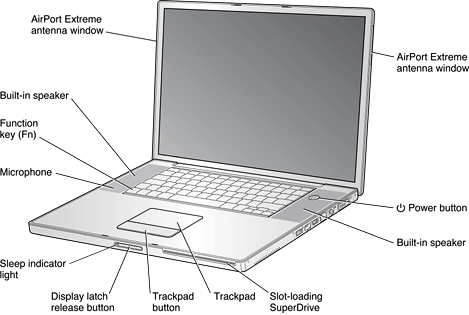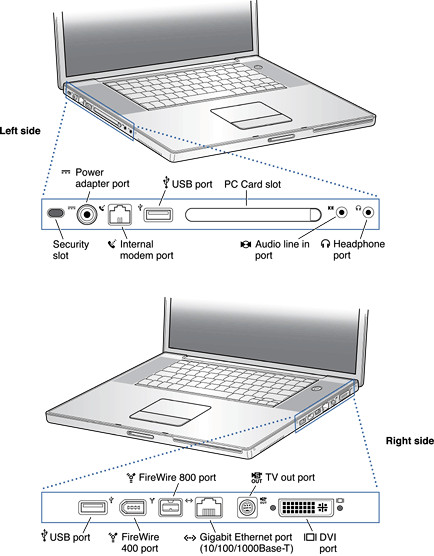Overview of PowerBook G4 17-inch
This chapter outlines the features of the PowerBook G4 17-inch computer.
In this section:
PowerBook G4 17-inch Features
Appearance
Peripheral Devices
System Software
PowerBook G4 17-inch Features
Here is a list of the features of the PowerBook G4 17-inch computer. Each feature is described in a later chapter, as indicated.
Processor The computer has a PowerPC G4 microprocessor running at a clock speed of 1 GHz. For more information, see “PowerPC G4 Microprocessor.”
System bus The speed of the system bus is 167 MHz.
Cache location and speed In addition to the L2 cache, which is internal to the processor IC, the computer also has a 1MB 5:1 L3 cache. See “Level 2 Cache” and “Level 3 Cache.”
RAM The computer has two standard PC2700 (333 MHz) DDR SO-DIMM expansion slots for SDRAM modules. The computer comes with 512 MB of SDRAM installed in one slot. See “RAM Expansion Slots.”
ROM The computer has 1 MB of boot ROM used by Open Firmware at startup. For information about the ROM, see “Boot ROM.” For information about Open Firmware, see “Open Firmware.”
Hard disk storage The computer comes with a built-in hard disk drive with a capacity of 60 GB. For more information, see “Hard Disk Drive.”
Display The display is a 100 dpi,17 inch wide-screen TFT with a resolution of 1440x900. See “Flat-Panel Display.”
External monitor The computer supports an external video monitor, using the DVI connector for a digital video display and an S-video connector for a PAL or NTSC video monitor. Included with the computer are a DVI-to-VGA adapter and an S-video-to-composite adapter; a DVI-to-ADC Apple Display Connector adapter is available separately. See “External Monitors.”
Graphics IC and memory The nVidia GeForce4 440 Go graphics controller operates on the AGP-4x bus along with 64 MB of DDR video SRAM. For more information, see “Video Display Subsystem.”
Battery bay The computer has a single battery bay. The battery uses lithium ion cells and provides 55 watt-hours at 10.8 V (nominal) for up to 4.5 hours.
Power adapter The computer comes with a 65 W power adapter with safety ground.
SuperDrive (DVD-R/CD-RW drive) The computer has a built-in DVD-R/CD-RW SuperDrive drive. For more information, see “SuperDrive (DVD-R /CD-RW).”
CardBus slot The computer has a CardBus slot that accepts one Type I or Type II PC Card or a CardBus Card. For more information, see “CardBus Slot.”
USB ports The computer has two USB 1.1 ports for an external keyboard, a mouse, and other USB devices, described in “USB Ports.”
FireWire ports The computer has one IEEE-1394a 400 Mbps serial FireWire 400 port and one IEEE-1394b 800 Mbps serial FireWire 800 port. For more information, see “FireWire Ports.”
Target disk mode The PowerBook G4 17-inch computer can act like a FireWire storage device connected to another computer. See “Target Disk Mode.”
Modem The computer has a built-in modem with 56 Kbps data rate and V.34, V.90, and V.92 support. For more information, see “Internal Modem.”
Ethernet The computer has a built in Ethernet port with an RJ-45 connector for 10Base-T, 100Base-T, and 1000Base-T operation. For more information, see “Ethernet Port.”
AirPort Extreme The fully-integrated, 54 Mbps AirPort Extreme provides a wireless LAN connection. For more information, see “AirPort Extreme.”
Bluetooth support Fully-integrated Bluetooth support enables short-range wireless connections between desktop and laptop computers and a host of other peripheral devices. For more information, see “Bluetooth Technology.”
Sound The computer has a built-in microphone, stereo speakers, a stereo headphone jack, and a sound input jack. See “Sound System.”
Keyboard The keyboard has an embedded numeric keypad and inverted-T arrow keys. Some of the function keys are used to control the display brightness and speaker volume. See “Keyboard.”
Trackpad The integrated trackpad includes tap/double-tap and drag features and palm-rejection capabilities. For more information, see “Trackpad.”
Weight The basic configuration weighs 6.8 pounds.
Size The computer is 15.4 inches (39.2 cm ) wide, 10.2 inches (25.9 cm) deep, and 1.0 inches (2.6 cm) thick.
Illuminated keyboard The computer has a backlit keyboard for optimal usability in all lighting conditions. For more information, see “Keyboard.”
Ambient light sensor The computer has an ambient light sensor which monitors light levels and activates the illuminated backlit keyboard and adjusts the display brightness.
Appearance
Figure 1-1 is a front view of the PowerBook G4 17-inch computer. Figure 1-2 provides side views showing the I/O ports.
Peripheral Devices
Included with the computer are a 65 W Apple Portable Power Adapter, an S-video-to-composite cable, and a DVI-to-VGA cable. In addition to these devices, the following peripheral devices are available separately:
The PowerBook G4 Rechargeable Battery is available as an additional or replacement battery.
The 65 W Apple Portable Power Adapter, which comes with the computer, is also available separately. The adapter can fully recharge a completely depleted battery in three hours or less while the computer is shut down or in sleep mode.
The Apple DVI to ADC Adapter, which enables the PowerBook G4 17-inch computer to support Apple’s ADC displays.
The Apple Pro Keyboard, a full-featured USB keyboard.
The Apple Pro Mouse, an optical USB mouse.
The AirPort Extreme Base Station.
A power cable for use on airliners is also available. The airline power cable should have a sense resistor of 24.3 K ohms +/-5% connected between the power plug's shell and ground. For more information, see “Power Controller.”
System Software
The PowerBook G4 17-inch computer comes with Mac OS X version 10.2. For the latest information, see the references listed in “Mac OS X.”
Here are a few items of interest about the system software on the PowerBook G4 17-inch computer.
Open Firmware
System software on all current Macintosh models uses a design based on Open Firmware. With this approach, the ROM on the main logic board contains only the Open Firmware code needed to initialize the hardware and load an operating system. The rest of the system code is loaded into RAM from disk or from the network. For more information, see the references listed in “Open Firmware.”
Computer Identification
Rather than reading the box flag or the model string and then making assumptions about the computer’s features, applications that need to find out the features of the computer should use IORegistry calls to test for the features they require. IORegistry calls are part of the I/O Kit API. For more information, see the references listed at “I/O Kit.”
Asset management software that reports the kind of computer it is running on can obtain the value of the model property from the IOService plane of the IORegistry. For the PowerBook G4 17-inch computer, the value of the model property is PowerBook5,1.
Power Saving Features
The PowerBook G4 17-inch computer has several profiles to save power. These profiles are labeled on the Energy Saver panel of System Preferences.
Reduced Processor Performance
The PowerBook G4 17-inch computer reduces both processor speed and voltage to save power. Reduced processor speed allows the software to change the processor’s clock speed, slowing down to conserve power or speeding up when more speed is needed. The slower clock speed is 667 MHz and the L3 cache is turned off.
The user interface for the reduced processor speed is located in the options tab under the Energy Saver panel in System Preferences.
Operating Modes
The power management protocols on the PowerBook G4 17-inch computer support two power-saving modes: idle and sleep.
Idle: The system is idling with the main processor stopped in a halted, low-power state. All clocks are running; the system can return to running code within a few nanoseconds. Cache coherency is maintained in this state.
Sleep: The system is completely shut down, with only the DRAM state preserved for quick recovery. All processors are powered off with their state preserved in DRAM. All clocks in the system are suspended except for the 32.768 kHz timebase crystal on the PMU99 IC.
The computer automatically enters idle mode after several seconds of inactivity. If the computer is attached to a network, it is able to respond to service requests and other events directed to the computer while it is in idle mode.
While it is connected to an AC power supply, the computer can also respond to network activity when it is in sleep mode. The user can enable this feature by selecting Wake-on-LAN in the Energy Saver panel of System Preferences.
When operating on the battery in sleep mode, the computer consumes less than 1 watt of power, meeting the Energy Star power-saving standard. When operating on the power adapter in sleep mode, the combined computer and adapter consume 3 to 4 watts of power.
Important: Peripherals such as PCMCIA cards and USB devices that do not conform to the computer’s power management protocols prevent the computer from switching to sleep mode and so deny the user the benefits of this energy-saving mode. When such peripherals are attached to the computer, the operating system displays a dialog to inform the user that the computer no longer meets the Energy Star requirements.
© 2003 Apple Computer, Inc. All Rights Reserved. (Last updated: 2003-03-01)

